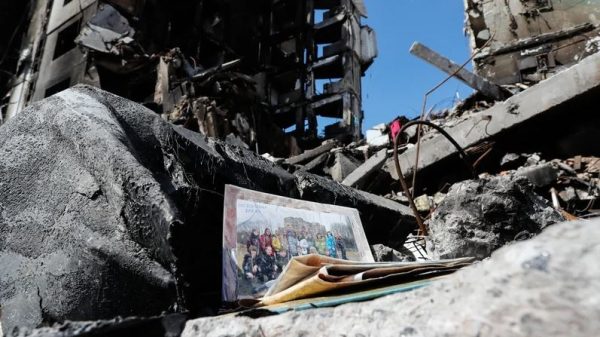Situation in Borodyanka ‘more dreadful’ than Bucha – Zelensky
April 19, 2022 · By RTE News for www.rte.ie

A group photo of Ukrainians is seen in the wreckage of a damaged residential building by the Russian air raids in Borodyanka
Situation in Borodyanka ‘more dreadful’ than Bucha – Zelensky
Ukrainian President Volodymyr Zelensky has said the situation in the town of Borodyanka was “significantly more dreadful” than in nearby Bucha, where Russian forces’ suspected killing of civilians has been broadly condemned.
In Borodyanka, about 60km northwest of the Ukrainian capital Kyiv, families looking for relatives watched diggers search through the rubble of an apartment block.
Most of the building was charred and its middle section had been razed to the ground, leaving a gaping hole.
“My mother, my brother, brother’s wife, his mother and father-in-law, are still there, as well as other people who were there in the basement,” resident Vadym Zagrebelnyi told Reuters.
“But there were other people on the upper floors there, and with children too. And I know for sure that they didn’t come out. I know they were there at that time.”
Mr Zelensky said in a video posted on the Telegram messaging service the devastation in Borodyanka was worse than in Bucha, where officials have said more than 300 people had been killed by Russian forces, with about 50 of them executed.
“It’s significantly more dreadful there. Even more victims from the Russian occupiers,” he said.
He did not provide any further detail or evidence that Russia was responsible for civilian deaths in the town.
Earlier, Ukraine’s prosecutor general, Iryna Venediktova, said in the Kyiv region, which includes Borodyanka, Bucha and other towns and villages such as Irpin, the authorities had found “650 dead bodies, from them it is 40 dead bodies only kids”.
Russia has denied targeting civilians and says images of bodies in Bucha were staged by the Ukrainian government to justify more sanctions against it and derail peace negotiations.
Borodyanka is about 25km from Bucha.
Few buildings remain standing in Borodyanka, the ones that do have burn marks running up their walls.
Among the rubble, a blue plastic child’s shoe could be seen.
“When you see that pattern developing then it becomes clearer and clearer and clearer that what we’re talking about is war crimes and also crimes against humanity,” said Wayne Jordash, a lawyer with the Global Rights Compliance law firm and foundation.
“I would say in Bucha they may even go further, it’s unclear at the moment, but there are indications there of genocide. That’s what I would say.”
The killing of civilians in Bucha has been widely condemned by the West as war crimes, building pressure for stricter sanctions against Russia.
“And what will happen when the world learns the whole truth about what the Russian military did in Mariupol?” Mr Zelensky asked.
“There, on almost every street, is what the world saw in Bucha and other towns in the Kyiv region after the withdrawal of Russian troops.”
Moscow says one of the aims of its military campaign is to “liberate” largely Russian-speaking places such as the southern port of Mariupol from the threat of genocide by Ukrainian nationalists, who it says have used civilians as human shields.
Mr Zelensky has rejected those claims, saying they are a baseless pretext for Russia’s invasion.
Ukraine villagers say Russian soldiers used them as ‘shields’
In the village of Obukhovychi, neighbours say Russian forces dug in around their houses, using them as a “shield” to discourage counter-attacks by Ukrainian armed forces.
On one road in the rural community – home to 1,500 before the war – AFP reporters saw five cavernous pits dug in spaces between homes and the street, and in gardens up against residential properties.
All were churned by wheel marks or tank tracks and strewn with ration packs, discarded military clothing and Russian and Belarusian cigarette packets.
Locals in the village – 70km northwest of Kyiv – said they were used by a variety of Russian army vehicles from mid-March until their withdrawal at the end of the month.
They dug the trenches to put the vehicles in and used us as a shield,” said 35-year-old Yulia Piankova.
The boundary wall of her property is marked with white paint reading “children” in Russian language. She has five, one of whom is disabled.
“It’s bad that they didn’t go into the field to fight, but they came to where they knew that many people were,” she said.
“It’s a central street and they went around and checked who was there. They took us from the cellar, counted us, and then started to dig the next day.”
Homes on the street are also hemmed in by foxholes and semi-permanent camps, crammed up against civilian addresses despite the wide open countryside in all directions.
Homes in the village bear evidence of artillery strikes. Windows have been blown out, walls are peppered with holes and buildings have been scarred by blasts.
On a road into the settlement there is a convoy of four destroyed trucks and a crippled tank.
By a communal green there is another destroyed lorry near improvised sleeping quarters dug in the earth.
“They were stationed everywhere in the village,” said 62-year-old Mykola Vareldzhan.
“They knew there were kids here, because when they came they went around the houses, checked documents.”
The use of human shields is forbidden under the Geneva Conventions, the international code of humanitarian conduct during wartime.
A 1977 protocol of the conventions dictates “civilians shall not be used to render certain points or areas immune from military operations, in particular in attempts to shield military objectives from attacks”.
The United Nations has said Russia’s widespread and indiscriminate attacks are of “immense concern”.






